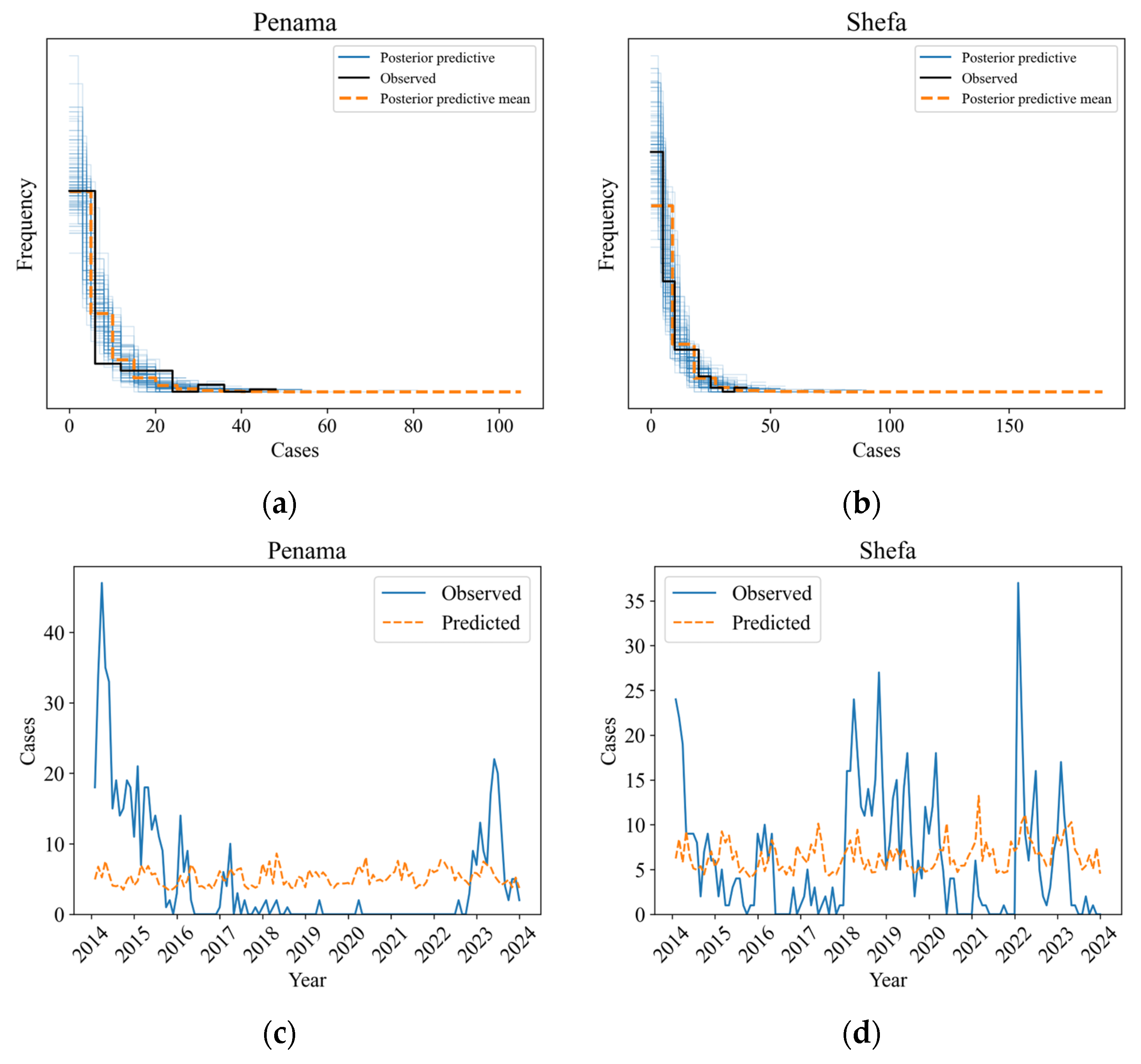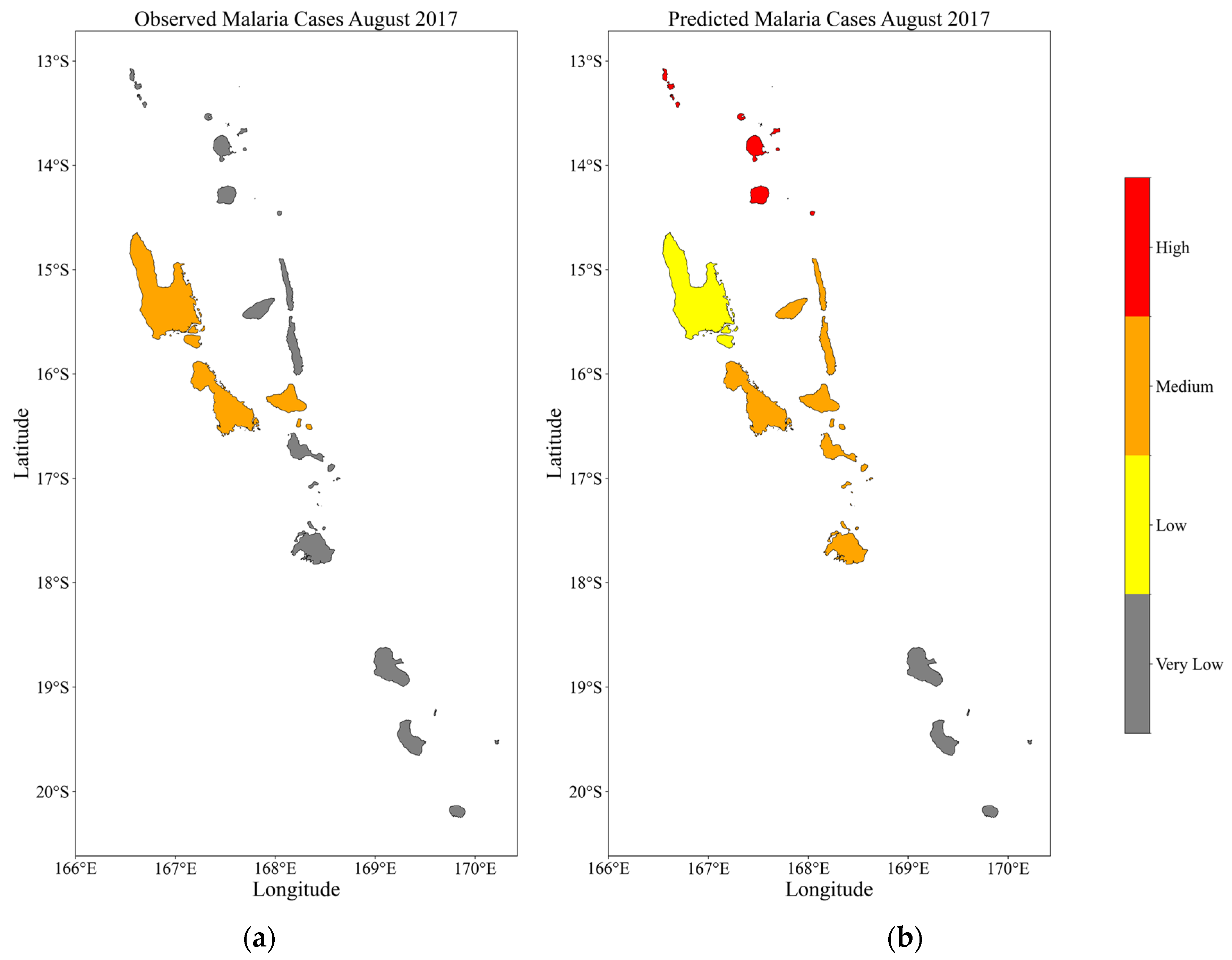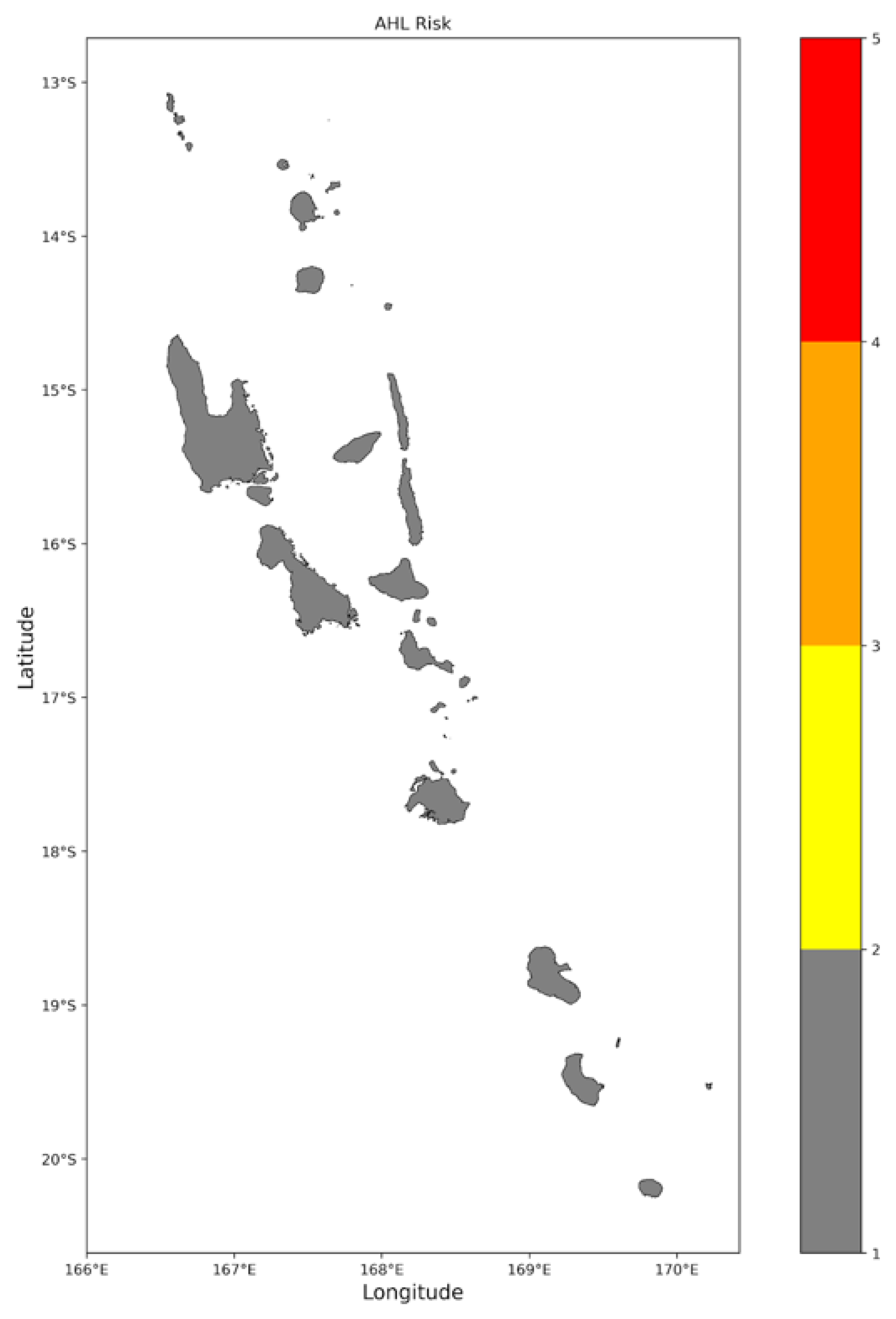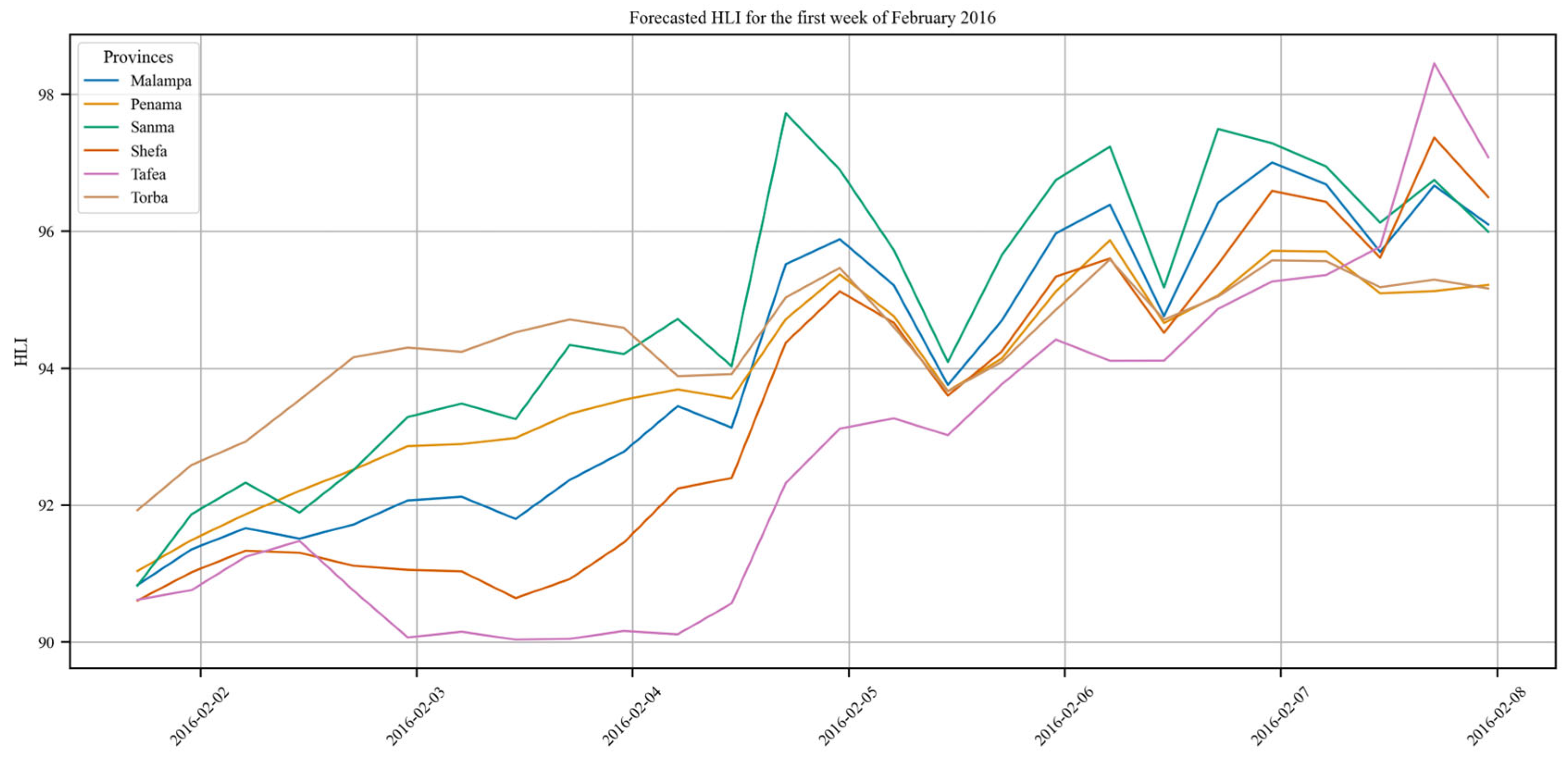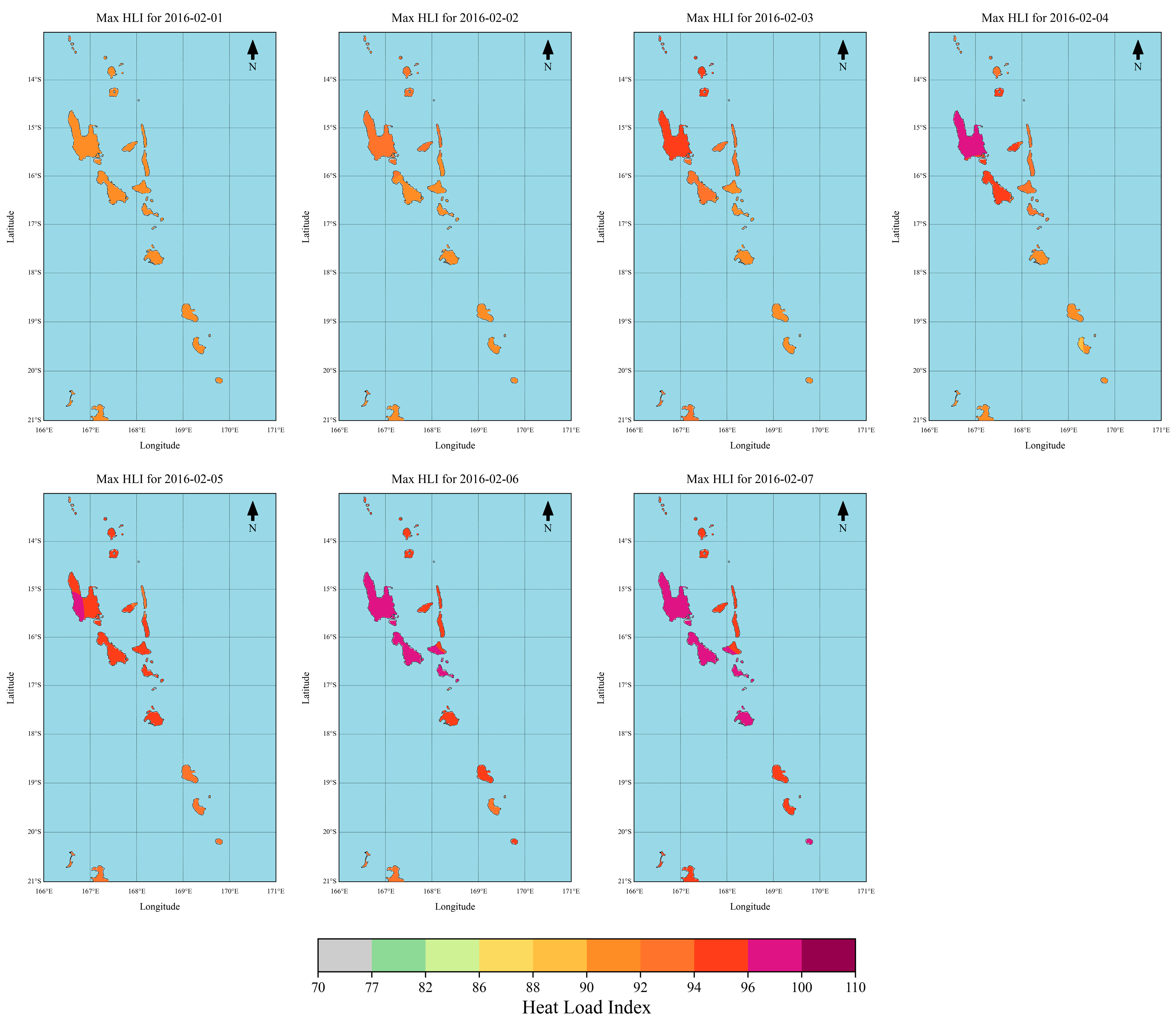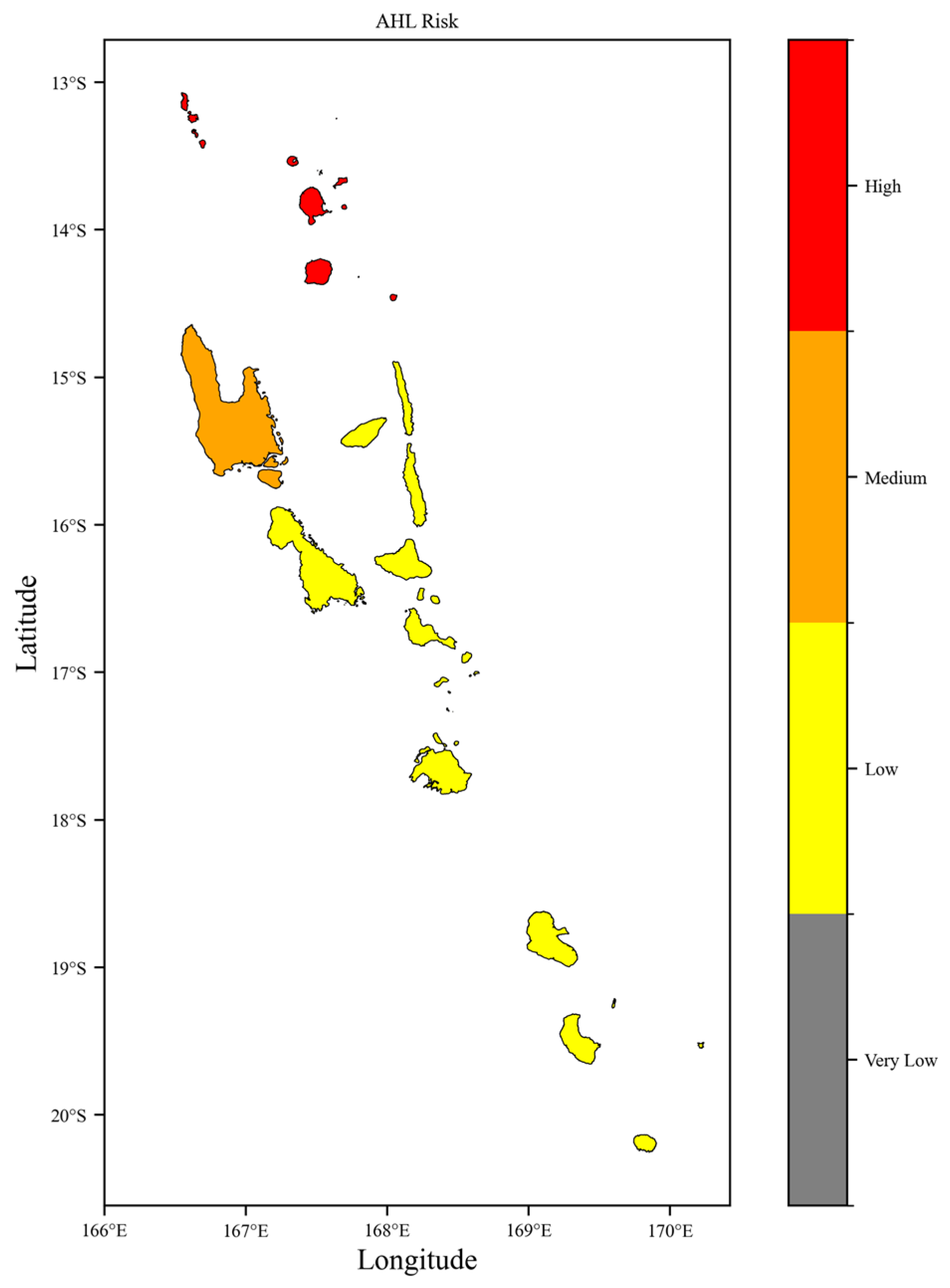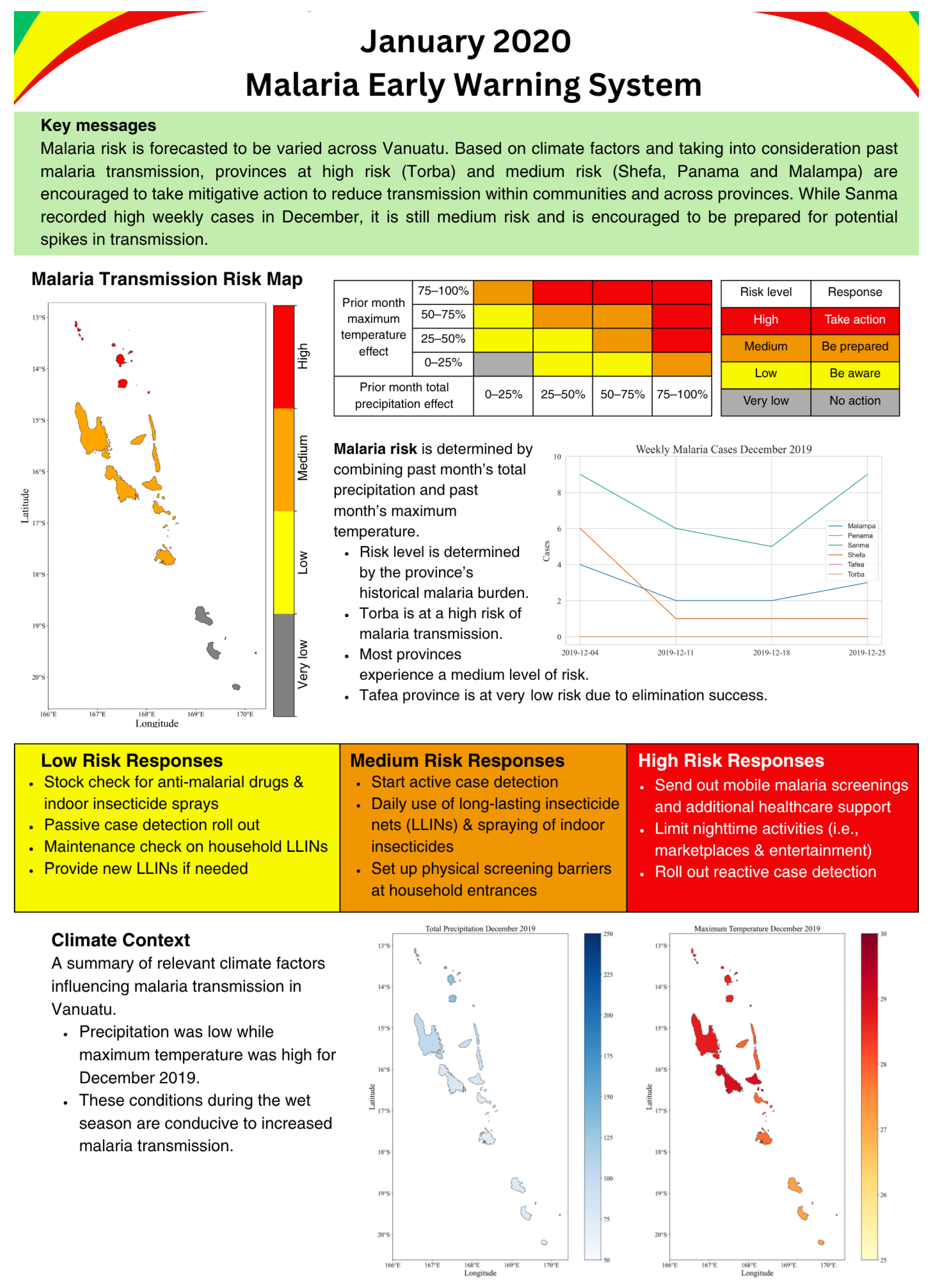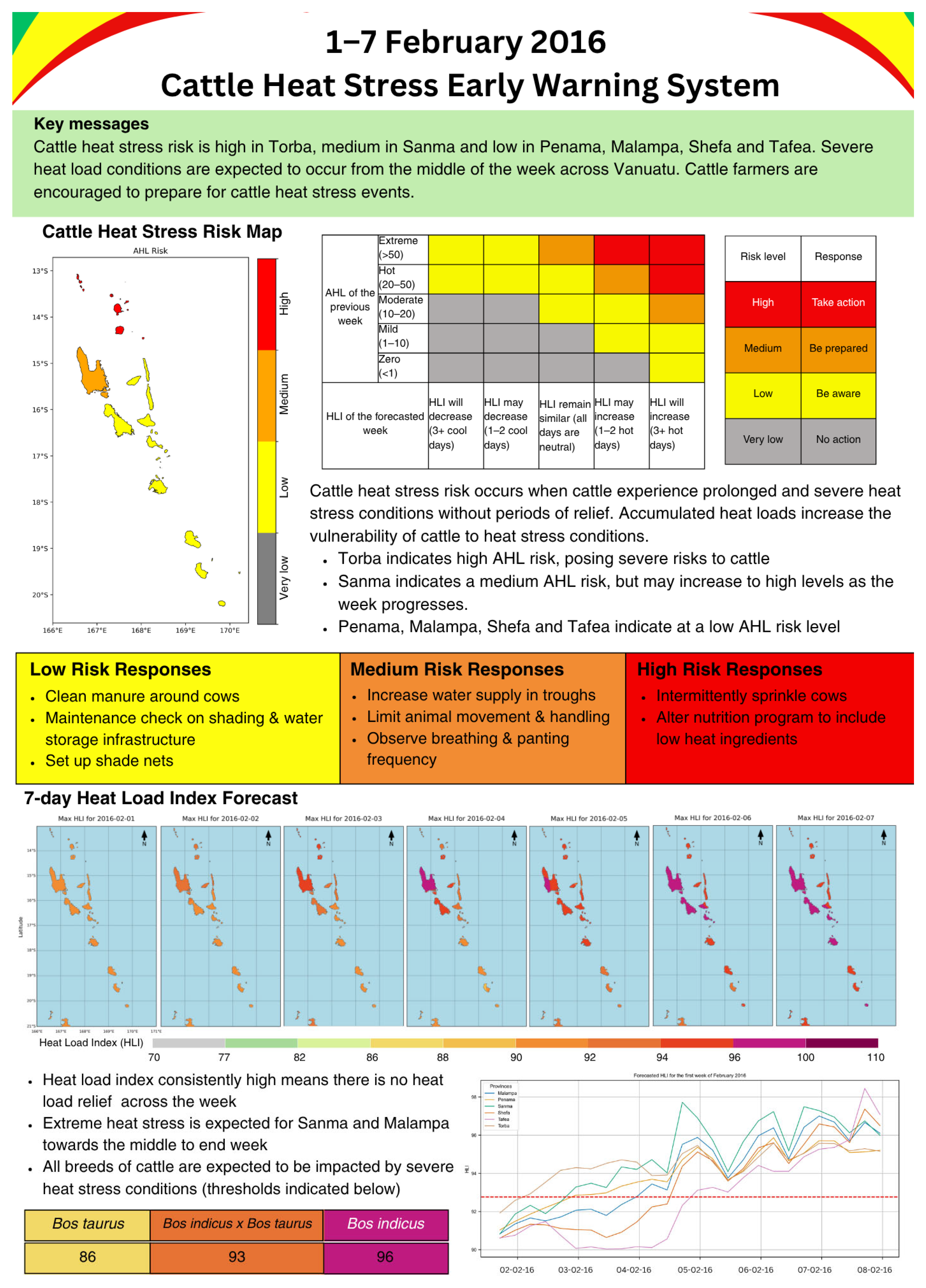1. Introduction
Anthropogenic climate change is increasing the frequency and severity of extreme climate events which harm global ecosystems and communities [
1]. To increase resilience to weather and climate hazards, global attention has been directed to building the capacity of Small Island Developing States (SIDSs) to prepare and respond to climate variability and change. Due to their geography, SIDSs are highly vulnerable to both the harmful effects of rapid-onset and slow-onset climate hazards, a condition that can be further compounded by limited institutional capacity and a high degree of exposure to systemic shocks [
1].
Vanuatu, a SIDS in the Southwest Pacific region, is one of several Pacific Island countries (PICs) that face slow-onset climate hazards such as increasing atmospheric and sea surface temperatures and sea level rise, as well as frequently occurring extreme weather and climate events (EWCEs), namely tropical cyclones, floods and drought [
2]. These climate risks cascade into significant sectoral and livelihood impacts, threatening Vanuatu’s long-term economic and social welfare. To minimise the social, environmental and economic impacts of natural hazards and EWCEs, it is crucial that communities and industries are informed about upcoming risks and possible mitigation measures.
Early warning systems (EWSs) are key elements in improving community preparedness and response to climate hazards, promoting timely action. On a global scale, the evolution of EWSs from single- to multi-hazard systems has been accelerated by intergovernmental institutions, multilateral organisations and international frameworks. These systems can address and warn stakeholders of multiple hazards and their interconnected impacts [
3]. In this way, an effective multi-hazard EWS (MHEWS) enables coordinated efforts to be directed towards hazard identification, monitoring and response. The World Meteorological Organization’s (WMO) Early Warnings for All Initiative is the most current program targeted at enhancing EWSs globally [
4]. The WMO emphasises the need for end-to-end and people-centred systems that enable communities, businesses and governments to prepare and respond to hazard risk and events [
4]. The initiative outlines several pillars as key to an effective EWS: risk knowledge, detection and forecasting of hazards, preparedness capabilities and warning communication.
Although Vanuatu’s natural hazard monitoring is relatively strong, a gap remains between predicting concurrent climate events and their real-world impacts. To address this, impact-based forecasting can provide actionable early warning information and promote proactive mitigation efforts [
5]. Impact-based forecasting emphasises the importance of EWSs that integrate predicted weather conditions and their impacts [
6,
7]. Operationalising impact-based forecasting in EWSs can therefore drive early response, enhance preparedness and minimise damage [
7]. The effectiveness of merging impact-based forecasting and EWSs has already been evidenced in PICs such as the Philippines, Papua New Guinea, Samoa and Tonga [
8,
9,
10]. Key features of these impact-based EWSs include translating the forecasting data and modelling into risk maps, risk matrices, key figures and simple key messages. Given that Vanuatu has a similar socio-economic profile and climate landscape to these countries, example systems from other PICs can serve as a precedent for developing impact-based forecasting EWSs in Vanuatu.
Of particular concern to Vanuatu is the risk of climate change to the public health and agriculture sectors. Predicting and mitigating the climate-related impacts on agriculture and health are key priorities for Vanuatu, sectors that are highly susceptible to increased climate variability [
11,
12]. Climate hazards and change have been seen to drive health challenges related to heat-related illnesses, food and water security and non-communicable and vector-borne diseases [
12]. These indirect effects increase the burden on healthcare facilities, a threat growing particularly from challenges related to food security and vector-borne disease [
13]. Environmental stressors often result in worsened animal health outcomes, through hazards such as heat stress, malnutrition and mortality. These stressors can compromise food security and human health, with many people in Vanuatu relying on livestock, cattle in particular, as a primary source of food and income [
14]. Climate change and EWCEs can further pose a risk to Vanuatu’s progress to eliminate vector-borne diseases, particularly malaria [
15]. Heat stress in agriculture and malaria transmission in public health are two distinct but compelling climate-related hazards to human health that remain relevant in Vanuatu. The dual focus on malaria transmission and cattle heat stress is highly relevant to the region’s public health and agricultural sectors, which are increasingly vulnerable to climate-related risks.
Given the far-reaching impacts of climate hazards in Vanuatu, EWSs that provide sector-specific warnings can present a targeted framework for optimising overall community health. Specifically, an agricultural EWS developed for cattle heat stress can enhance agricultural production and food-related health outcomes by indicating the potential impacts of climate conditions on cattle, supporting timely preparedness and response. In parallel, a health sector EWS targeting malaria transmission can prepare healthcare services and communities in the event of an outbreak. Together, climate-based EWSs targeting different key sectors in Vanuatu can have an enhanced impact on health outcomes and in future be integrated into an MHEWS.
1.1. Malaria in Vanuatu
Malaria transmission and outbreaks are a pressing public health challenge in Vanuatu. Malaria is endemic to Vanuatu, with the parasite
Plasmodium vivax being transmitted by the mosquito vector
Anopheles farauti [
16,
17]. In 2023, Vanuatu reported an incidence of 7.14 cases per 1000 population, a number that is potentially underrepresented due to asymptomatic transmission and limited access to health facilities and diagnostics [
15,
18]. Vanuatu is a participant in global malaria elimination initiatives, with the Ministry of Health (MoH) also directing national and subnational campaigns. In particular, these campaigns focus on the distribution and coverage of insecticide-treated nets and diagnostic materials [
15].
As Vanuatu’s control measures progress, malaria distribution is increasingly concentrated in isolated locations. Provinces Tafea and Torba have been a particular focus for elimination programs, with Tafea being declared malaria free in 2017 [
19]. Torba was similarly progressing towards elimination, but in 2022, experienced increases in malaria cases that have been associated with COVID-19 outbreaks competing as a national health challenge [
15]. In 2023, tropical cyclones Kevin and Judy further impacted health services [
15]. These compounding health challenges, social factors of transmission and
An. farauti presence can threaten provincial and national elimination progress [
20,
21].
The National Strategic Plan for Malaria Elimination 2021–2026 highlights the need for strengthened elimination-related knowledge and practices, and the promotion of sophisticated surveillance systems [
21]. Currently, Vanuatu reports and collates malaria data using a rapid electronic notification system, initially implemented in response to COVID-19’s presence in the country, supplementing weekly reporting of diseases through the Pacific Public Health Surveillance Network [
22]. Additionally, the 7-1-7 tool used to strengthen outbreak response is being trialled in Vanuatu, setting goals to identify outbreaks in less than seven days, report them in one and take action to control the outbreak in a further seven days [
23]. Both approaches aid in strengthening disease and outbreak management but could further be supported by a climate-based system that predicts high-risk periods. Drawing on the established influence between climate factors and malaria incidence, a predictive system can enhance sector knowledge and awareness of malaria dynamics and encourage proactive mitigation.
Like many vector-borne diseases, malaria has a sensitivity to climate variables—a relationship that has been explored in the South Pacific region [
24,
25,
26,
27,
28]. Stages of the transmission cycle can be influenced by climate conditions, such as the rate of parasite development within the mosquito and the biting rates and aggressiveness of adult females [
24,
26,
29]. While these climate–malaria relationships vary depending on region-specific factors such as topography and infrastructure, studies in PICs often find a strong, positive influence from temperature, over time contributing to greater numbers of infectious adult mosquitoes [
26,
27,
28,
30]. Precipitation is also influential in malaria spread, with its effect largely modulated by the regional environmental conditions and influencing the habitat availability of
An. farauti breeding [
27,
31]. In areas with few existing larval habitats, or vegetation and topography that are not conducive to larval habitat permanence, rainfall tends to have a positive association with malaria incidence, though this relationship varies seasonally and between regions [
25,
27,
32]. Like temperature, the influence that rainfall may have on malaria incidence tends to be lagged [
25,
30].
The predictive relationship between climate variables and disease incidence can form the basis of a climate-based malaria EWS, such as was developed for the Solomon Islands using six-month rainfall outlooks [
25]. An EWS built to effectively predict malaria risk should incorporate region-specific climate conditions and supplement existing healthcare infrastructure. Using climate models to forecast periods of high malaria risk before outbreaks occur can provide vital lead times for public health interventions, allowing for enhanced risk communication and distribution of resources [
18].
1.2. Cattle Heat Stress in Vanuatu
Cattle are an essential aspect of Vanuatu’s agricultural systems and food security, with the sustainability of the industry being vital to population health and livelihoods [
33,
34]. Over 80% of Vanuatu’s population is involved in some form of agriculture for subsistence, livelihood or income [
14]. In 2011, beef was the nation’s fourth-largest exported commodity, and its production continues to constitute a significant portion of Vanuatu’s agricultural industry income [
35]. The beef herd in Vanuatu currently consists of approximately 90,000 head of cattle, 40% of which are owned by smallholders [
14,
36]. Half of all rural households in Vanuatu raise cattle, making them a central aspect of the country’s culture and lifestyle, with cattle playing a crucial role in local ceremonies, traditions and the generation of rural incomes [
14]. Vanuatu’s beef sector has significant potential for growth, supported by export-accredited abattoirs and Ministry of Agriculture, Livestock, Forestry, Fisheries and Biosecurity (MALFFB) plans to expand the national herd to 500,000 by 2025 [
34,
37]. Given the importance of cattle to farmers, rural households and the Vanuatu economy, monitoring the impact of climate variability and change on cattle health and production is critical [
38].
Heat stress in cattle can arise from a combination of environmental and internal factors, impacting cattle health, welfare and productivity [
39]. The condition is typically triggered by the surrounding thermal environment when high ambient temperatures and humidity combine with decreased wind speeds and cloud cover. This can lead to reduced evapotranspiration rates, hindering the physiological cooling mechanisms of cattle, limiting their ability to offload heat [
40,
41]. The main impacts of heat stress on cattle include decreased nutrient absorption efficiencies, feed intake and weight gain [
42]. Further physiological impacts include impaired reproductive cycling, decreased milk production, fertility, embryonic development, pregnancy rates and neonatal calf survival rates [
40,
43]. Severe or prolonged exposure to heat stress conditions can eventually result in cattle death. In Vanuatu, elevated temperatures and humidity during the wet season impede effective heat dissipation in cattle, resulting in frequent, and often daily, exposure to heat stress conditions [
44,
45].
Predicting and quantifying the effect of climate variables on cattle is essential to managing and maintaining their health, welfare and productivity. The Heat Load Index (HLI), which incorporates temperature, humidity, wind speed and solar radiation, serves as a reliable instantaneous indicator of cattle heat stress [
46]. Cattle can often avoid the worst effects of daily heat stress if the climatic conditions at night allow sufficient cooling for recovery from the heat stress experienced during the day. However, when cattle experience heat stress over consecutive days or if nighttime conditions are inadequate for cooling, cattle can begin to accumulate a ‘heat load’. An Accumulated Heat Load (AHL) refers to the ‘carry over’ of heat load from previous hours or days and can exacerbate the impacts of heat stress over time. An AHL leads to more severe and persistent physiological issues, compounding the impacts of heat stress on cattle health, productivity and mortality [
40]. The impact of an AHL on cattle is measured using the AHL index, a measurement calculated using the HLI and HLI thresholds determined in earlier research by Gaughan et al. [
46].
While cattle are often able to recover from days with an intense (high) HLI, this resilience is impaired if cattle are exposed to prolonged periods of heat stress, characterised by high AHL values [
47]. These periods can have severe and long-lasting impacts on cattle health, with cattle unlikely to return to their peak performance potential after experiencing such an event. As an AHL is calculated using climate conditions, the development of an EWS for cattle heat stress with the predictive capacity to forecast when and to what extent the AHL will increase is both plausible and valuable. Early warning prior to periods of prolonged or severe heat stress conditions can enhance feedlot operator and farmer preparedness, supporting agricultural and food security [
48].
To date, EWSs in Vanuatu have monitored and forecasted single climate hazards and meteorological scenarios. However, with the growing impact of increased climate variability and change, hazards are likely to occur concurrently, creating cumulative stressors for communities and industries. Improving understanding of the function of EWSs in Vanuatu can enhance current management and preparedness measures at a regional and local level. This study aims to develop two components that could contribute to a climate-based MHEWS in Vanuatu, applying a framework for producing an EWS bulletin to two distinct hazards: malaria transmission and cattle heat stress. This study further aims to explore the influence of climate variables on malaria transmission and cattle heat stress to develop forecasting models, the results of which are presented through the bulletins.
By providing accessible climate hazard information, the two EWS frameworks explored in this study can assist industries and stakeholders in taking measures in preparedness for malaria outbreaks and cattle heat stress events. Given the predicted increase in climate variability and in the intensity and frequency of EWCEs, this information is crucial to support the long-term resilience of Vanuatu’s public and animal health sectors.
4. Discussion
4.1. Malaria Early Warning System
4.1.1. Malaria Early Warning System Delivery and End-Users
Vanuatu’s healthcare sector is characterised by a complex web of multidisciplinary stakeholders. While the malaria EWS bulletin is targeted at the MoH, it is beneficial to understand how the early warning information would be distributed throughout the healthcare sector and reach end-users. Engagement in malaria elimination has been found to be greater when influential community members encourage the wider community to engage with malaria prevention initiatives [
67]. Atkinson et al. (2010) found that, across provinces, the flow of health information cascaded forward from health officers, campaign teams and village health workers to other community leaders such as chiefs, church leaders and teachers [
68]. Harnessing this flow of information, adopting clear and standardised messaging that reinforces the importance of consistent use of malaria prevention measures was found to be most effective in promoting community action. Such findings provide a framework for the MoH to identify which stakeholders can be engaged when malaria risk increases and response strategies need to be actioned.
4.1.2. Malaria Response Strategies
It is critical that knowledge and awareness of malaria risk is combined with safe and effective behavioural practices [
69]. The EWS bulletins combine the model’s predicted malaria risk with response strategies to indicate to the MoH how communities and sectors can adequately respond to increases in malaria transmission, with a particular focus on surveillance and vector control. As a health priority nationally, surveillance is targeted at all provinces with active malaria loci [
21]. In Vanuatu, malaria case surveillance includes active case detection (ACD), which can be either proactive or reactive, as well as passive case detection (PCD). ACD detects cases through screening in communities and households located in high-risk areas, increasing early detection of cases, while PCD refers to case detection among patients seeking treatment in a health centre [
21,
70]. Key vector control methods in Vanuatu include long-lasting insecticide nets (LLINs) and indoor residual spraying (IRS). In 2023, over 50,000 LLINs were distributed nationally, achieving 92% of the target amount [
15]. IRS is primarily targeted in houses and neighbouring areas in response to suspected or confirmed cases, and was a key action conducted in 2023 responding to Torba and Sanma outbreaks [
15,
71].
Table 6 outlines response strategies intended to show MoH decision makers how communities and industries can reduce malaria transmission based on their month-to-month risk levels. Corresponding to the malaria risk matrix (
Figure 6), the evidence-based response strategies inform the ‘Responses’ section in the malaria EWS bulletin.
4.1.3. Malaria Model Performance
The model showed better predictive ability for provinces with consistently high malaria cases between 2014 and 2023, shown in Sanma and Malampa. This may be associated with the distribution of health facilities across Vanuatu, where major health centres are in Sanma and Malampa [
20,
21]. In contrast, the model for Torba, a province with low case burden until spikes in 2022, predicted higher case numbers than were observed. However, a key increase in cases not captured in the Torba model overlaps with the sharp jump in COVID-19 presence in Vanuatu [
80]. These unexpected events can impede individuals’ ability to seek healthcare, further contributing to outbreak vulnerability and worsened health outcomes [
15,
81,
82].
The malaria EWS, based on prior climate conditions, accounted for the general influence of climate on mosquito and parasite development. This ensured that model predictions remained in an appropriate time frame in relation to diagnosed cases, where mosquito habitat availability (influenced by precipitation), lifecycle rates and biting aggression (influenced by temperature) exert influence in the weeks leading up to an individual presenting malaria symptoms, not months [
25,
26,
27,
29,
31]. All climate variables in the model showed positive relationships with malaria incidence of varied strengths, with total lagged precipitation having a weaker influence than temperature. Maximum lagged temperature had the strongest influence on cases, a relationship that has been explored previously in the South Pacific region [
26,
27,
30].
The wide HDIs shown in multiple provincial models indicated uncertainty that should be considered in predictions, likely due to extraneous variables. A predictive malaria model is limited by using only climate data, and its accuracy and adaptability to changing epidemiological contexts could be improved by incorporating external factors. Climate data do not account for aspects of social and infrastructural aspects of transmission, such as elimination progress, population movement and access to healthcare services, all of which have been previously associated with variable malaria transmission in Vanuatu [
15,
20,
21]. In particular, access to and by healthcare services is a significant factor in malaria risk in Vanuatu, where malaria burden is increasingly concentrated in hard-to-reach areas [
74,
82]. Further, competing outbreaks and EWCEs are likely to be influential, and future modelling would benefit from exploring these factors.
Evaluation of the model’s tendency to over- or underestimate risk is crucial when considering its usefulness as an operational system. The climate-based model produced different periods of over- and underestimated risk, predictions that may reduce user trust. When malaria risk is overestimated, nonessential implementation of the response strategies may have financial or infrastructural implications [
70]. While periods of underestimated risk occurred less frequently, in an operationalised EWS, these would likely have more severe implications for community health. Underestimating malaria risk may reduce risk perception and limit opportunities to prevent or treat cases, and outbreaks may go undetected. Climate models and predictions should be supplemented with non-climate risk information and expert knowledge, and uncertainty should be communicated.
The climate-based predictions help indicate ‘receptive’ areas to malaria transmission, where the environmental conditions are likely suitable for transmission and increased vectorial capacity [
83]. This climate suitability of a province for malaria transmission is then supplemented by bulletin information and decision-maker knowledge. In the process of developing the case study bulletin, a malaria risk was mapped for a low-risk period (August 2017) and found promising performance of the methodology to indicate risk in variable conditions (
Appendix C).
4.2. Cattle Heat Stress Early Warning System
4.2.1. Cattle Heat Stress Early Warning System Delivery and End-Users
In Vanuatu, the authority over livestock health and productivity is primarily held by the MALFFB, with the Department of Livestock specifically responsible for overseeing the country’s beef industry [
37]. There is limited information regarding the broader stakeholders involved in cattle farming; however, the Vanuatu National Livestock Policy 2015–2030 mentions the role of commercial farmers, smallholder and subsistence livestock farmers and feedlot operators in sustaining the country’s beef industry [
37]. To this end, the cattle heat stress EWS is targeted at the MALFBB with the assumption that its contents and warnings will be disseminated to the broader livestock sector.
In this study, the weekly EWS bulletin allows for greater accuracy of warning information, providing a more realistic depiction of the climate and weather conditions conducive to worsening cattle heat stress. Unlike a weekly average forecast, daily HLI and daily maximum HLI measurements use granular climate and weather data to indicate to farmers when and where during the week cattle may be exposed to heat stress conditions. This early warning information can provide these end-users with adequate time to adopt appropriate actions to mitigate heat stress during adverse conditions [
48]. The EWS model developed in this study displays the full range of HLI values for each province on all days within the forecasted week, rather than focusing on average HLI measurements or instances when the HLI exceeds a predetermined threshold. Since HLI thresholds can vary due to intrinsic and extrinsic factors, based on earlier research by Gaughan et al. (2008), this approach provides farmers and feedlot operators with the flexibility to establish and use customised HLI thresholds that are specific to their circumstances [
46]. This specification will enable farmers to better interpret the relative risk of the forecasted heat stress conditions.
Recognising that farmers and end-users operate under unique conditions, with individual cattle factors that will exert varied influences, the full display of HLI values across the bulletin ensures the provision of comprehensive and targeted information. As a result, farmers operating in different contexts can analyse the same national data and draw useful conclusions tailored to their own unique circumstances. The information provided in the EWS allows them to better manage their livestock during heat stress periods by interpreting the forecasted HLI data according to the specific tolerance levels of the cattle in their farming environment. Acknowledging this, the cattle heat stress EWS bulletin has been designed to support Vanuatu’s animal agriculture sector with relevant, accessible and feasible management strategies tied to HLI thresholds and heat load risk. The bulletin equips farmers with information that enables timely action to mitigate the effects of heat stress, helping them protect their livestock and livelihoods amidst climate variability.
4.2.2. Cattle Heat Stress Response Strategies
The animal agriculture sector is increasingly dependent on technological solutions to prepare for and respond to the challenges posed by a warming climate, though this is not always feasible [
62]. Therefore, it is critical to develop context-specific approaches for managing cattle heat stress, ensuring solutions are both practical and effective given local contexts and potential barriers. However, effective mitigation strategies specific to Vanuatu’s agriculture industry remain limited [
84]. As such, the following response strategies have been informed by reports and research into cattle heat stress in other regions such as Australia, North America and Europe [
61,
85,
86,
87]. Given that multiple breeds of cattle are present in Vanuatu, the following response strategies provide more general guidance to the MALFFB, which can then be passed on to farmers and feedlot operators.
Table 7 presents the response strategies for each risk level and response level that corresponds to the cattle heat stress risk matrix (
Figure 10). The evidence-based management strategies will vary week to week as informed by the seven-day HLI threshold and AHL risk map. Due to different climate profiles, provinces can be categorised with varying risk levels. Therefore, response strategies for each risk level will be presented on the bulletin.
4.2.3. Cattle Heat Stress Model Performance
The risk model demonstrated strong performance, capturing the varied heightened risk scenarios across provinces during periods of elevated HLI values (
Figure 11). It effectively highlighted provinces with the greatest risk, such as Torba and Sanma, exhibiting the model’s ability to predict severe heat stress conditions. This high-risk scenario validation reinforces the robustness of the risk matrix, which successfully integrates forecasted HLI thresholds and AHL trends. Additionally, the model’s effectiveness in depicting a low-risk scenario during the 1st–7th of January 2023 (as shown in
Appendix D) further supports its reliability across varying levels of heat stress risk.
The accuracy performance of the cattle heat stress model is primarily determined by the accuracy of the climate forecast data used within the model, as the HLI is a well-established and reliable method for assessing heat stress in cattle. To enhance the model’s accuracy and specificity to each province, future expansion of the model can incorporate observations from local weather stations in Vanuatu. Additionally, more frequent readings from these stations would provide a higher resolution of forecast information, offering greater insight into the timing and intensity of heat stress events.
4.3. Malaria Transmission and Cattle Heat Stress Bulletins
Effective early warning messages are characterised as containing three key components: the characteristics of the risk, predicted impact and recommended actions that individuals should adopt considering the risk and/or threat [
93,
94,
95]. In this study, the design of the EWSs was informed by the WMO Early Warnings for All Initiative, which emphasises the need for greater coordination between monitoring, preparedness and response, and warning dissemination and communication. An additional document referenced during the design of the EWS bulletins was the WMO’s MHEWS checklist which was created as a reference tool for EWS development [
96]. Together, these key sources provided a framework within which one-page bulletins were developed for the MoH and MALFFB. The malaria EWS bulletin and cattle heat stress EWS bulletin are displayed in
Figure 12 and
Figure 13.
4.3.1. Design Considerations
The malaria transmission and cattle heat stress EWS bulletins integrate insights from the forecast models and risk maps with findings from the literature review on EWS design, communication strategies and mitigation responses. The January 2020 and February 2016 case studies for malaria and cattle heat stress each demonstrate the bulletins’ ability to warn stakeholders of high-risk periods and provide guidance for efficient preparation and effective response. Foundational to the design of the EWS bulletins in this study was the Papua New Guinea drought bulletin created by the Climate Risk and Early Warning Systems (CREWS) team [
97]. Adopting the CREWS design, the malaria and cattle heat stress bulletins comprise of three key components that are prioritised in ordering: key messages, risk maps and associated responses, and climate context. This format considers that decision makers from the MoH and MALFFB may only read the beginning of the document so the most critical information—key messages and risk maps with associated responses—is presented first. The bulletins include climate context through temperature and precipitation maps in the malaria EWS and the seven-day HLI forecast in the cattle heat stress EWS. This provides additional information on the climate factors considered in the respective forecasting models.
To ensure the EWS bulletins are accessible and user-centred, this study combined the thresholds used in the risk matrices (
Figure 6 and
Figure 10) to communicate the predicted impact on public health and animal health sectors. Given that there are no consistent risk categories used in malaria and cattle heat stress EWSs, this study prioritised simple and accessible language as emphasised in the WMO’s Early Warnings for All Initiative [
4]. The categories ‘Very Low’, ‘Low’, ‘Medium’ and ‘High’ and respective colour schemes grey, yellow, orange and red were used to communicate increasing risk in the bulletins. Diverging from Dash (2024) and Taylor et al. (2024), this study opted for grey instead of green to represent ‘Very Low’ in the bulletins to consider possible colour vision deficiency in some end-users [
64,
65].
A key tenet of an effective EWS bulletin is that it is user-centred and relevant for the designated target audience [
98,
99]. Historically, EWSs have been limited by their inability to communicate outputs in a user-friendly, accessible format [
100,
101]. As a result, the system itself may fail to adequately incite timely responses, ultimately leading to reduced protective actions [
102]. In this study, a user-centred approach was adopted when designing the bulletins to ensure that the technical model information was practical and understandable. A key consideration in the EWS bulletins was providing response strategies that are evidence-based and specific to Vanuatu’s geographic and socio-economic context (
Table 6 and
Table 7). Furthermore, since the target audience is the MoH and MALFFB rather than local communities, the bulletins use more technical language and references when listing response strategies to align with assumed baseline knowledge of experts and decision makers in the relevant Ministries. It is intended that the bulletins provide the MoH and MALFFB with information and adaptation strategies that are practical for end-users, thus ensuring long-term sustainability of the EWSs.
4.3.2. The Role of Risk Perception in the Malaria Transmission Bulletin
The effectiveness of an EWS not only depends on the presentation of the information but also on complex social factors such as personal experience, risk evaluation and traditional risk management [
93]. The increase in monitoring and surveillance of malaria alongside increased preventive strategies is likely going to lead to the decreased prevalence or even absence of malaria in communities, to the extent that most provinces may be recording risk levels of ‘Very Low’ and ‘Low’. While rare reporting of cases indicates positive progress towards Vanuatu’s national elimination goal, it can also render malaria prevention a low priority for health workers and communities. This may lower risk perception and prioritisation of malaria and prevention practices, potentially increasing a community’s susceptibility to outbreaks.
Risk perception is a key determinant of malaria response and mitigation [
68,
78,
103,
104,
105]. Focusing on elimination efforts in the Tafea region, Atkinson et al. (2010) reported that risk perception was a key barrier to the decision to use bed nets and the consistency of their use within a given period [
68]. Their study found that individuals who perceived themselves or close family members to be at risk of malaria transmission were more likely to use bed nets. It was further found that the perceived presence of mosquitoes was a key determinant of bed net use, i.e., if low mosquito presence was observed, bed net use would decrease. Similarly, Watanabe et al. (2014) found that communities located in the Ambae Island of the Penama region were opting not to use bed nets when there was a perceived absence of malaria transmission and mosquito presence [
72].
While mitigation strategies are crucial to eliminating malaria, the motivation to do so is shaped by intrinsic individual factors and extrinsic social factors such as inter- and intra-community characteristics, cultural contexts and environmental conditions [
68,
106]. For instance, in contrast to Watanabe et al.’s (2014) findings for Ambae, the island of Aneityum reported sustained bed net use irrespective of the wet/dry season and malaria presence [
72]. This was attributed to collective and community-based action and individual motivation. Reports from interviews and group discussions revealed a positive feedback loop among community members; sustained motivation increased risk knowledge which encouraged healthy habits and mitigation action, which, when combined, amplified motivation. It is here that the malaria EWS bulletin can catalyse a similar feedback loop in other provinces. As the malaria EWS bulletin is intended to identify and warn the MoH of at-risk populations, this can cascade forward into increased alerts to at-risk communities, generating greater risk knowledge, motivation and intervention.
4.4. Future Directions
It is intended that these proof-of-concept forecast models and corresponding EWS bulletins are expanded upon by the MoH and MALFFB. It is anticipated that the response strategies will largely stay consistent. In comparison, the key messages and graph interpretations on the bulletins will require alteration each month (malaria EWS bulletin) and week (cattle heat stress EWS bulletin). For EWSs, and a future MHEWS, to be operationalised and user-centred, co-design with ministries focusing on local knowledge, capacity assessments and program evaluation must be integrated. It is expected that the bulletins will undergo several iterations upon further feedback and evaluation from the MoH and MALFFB, ensuring that the bulletins are practical and relevant to target users. For example, this may involve greater incorporation of traditional knowledge (TK) and translation of the bulletins into Bislama. Local knowledges have been shown to be effective in malaria suppression and response, building climate resilient communities and facilitating collective action [
100,
107,
108,
109]. Facets of TK can be integrated into the MHEWS bulletins, prompting greater community engagement in risk management behaviours. To do so, iterative feedback with the MoH, MALFFB, community leaders and individuals can provide a more comprehensive overview of TK surrounding public and animal health; incorporating TK and translating the bulletins can help broaden their reach and improve their accessibility.
For an operational EWS, an assessment of the implementation pathway would be crucial, evaluating ministry capacity and potential financial or technical barriers, and further improving both models’ accuracy and usability. Further, as research into climate-based EWSs continues, particularly in other PICs, the proof-of-concept EWSs developed in this study should be kept current and aligned with regional best practices.
These EWSs were developed with the aim to explore aspects of a future MHEWS for Vanuatu, responding to climate impacts with a shared methodology to produce EWS bulletins. To develop an MHEWS, these separate outputs of malaria and cattle heat stress bulletins could be further integrated to present interconnected risks and support decision making. An effective MHEWS for Vanuatu would benefit from a common risk communication strategy, which was explored through the bulletin design considerations but could be presented in a risk dashboard, providing a comprehensive resource for decision making and prioritising. The approach to modelling and bulletin design may require revision if the categorisation of risk changes due to changes in malaria burden and/or worsened heat conditions in Vanuatu. In the malaria forecast model, risk percentiles and the relevant risk categories may need to be adapted based on ongoing case burden or outbreaks. Similarly, if re-establishment of cases occurs in Tafea, this province will need to be added into the forecast model. While the thresholds for the cattle heat stress indices are unlikely to change, climate change and variability are predicted to increase atmospheric temperatures, resulting in more frequent surpassing of the HLI and AHL thresholds. As a result, more cattle are likely to be more heat stressed within a given week, so much so that the risk categories may need to be adjusted to account for this.
The provincial spatial scale used in both models may limit the accuracy of predictions, simplifying geographical features like altitude or vegetation, or for local concentrations of malaria burden. These smaller-scale factors are likely to influence the climate variables used in the models, particularly in larger provinces. Expanding on these models with higher-resolution data would likely improve predictions, particularly the influence of altitude on rainfall and temperature, and existing malaria burden within a specific community in the malaria model, and through coastal effects and vegetation in the cattle heat stress model. However, a malaria model focused on a finer spatial resolution than a provincial scale would further reduce the sample size of monthly cases, particularly if the model is refined to a health zone scale. In the cattle heat stress model, due to the spatial and temporal limitations of ECMWF’s seasonal forecasting data, future research should explore using local weather station data from Vanuatu into the forecasting models. This data could better capture the microclimates and specific conditions unique to different regions. On a temporal scale, the lack of available hourly forecasting data meant that the weekly AHL forecast could not be calculated. This was addressed through the inclusion of an AHL risk matrix and map; however, future studies could explore the possibility of directly incorporating a calculated AHL into models, further informing more specific mitigation strategies.
Both models could be supplemented using observational data to improve Vanuatu-specific predictions and mitigation strategies. For malaria, predictions could be compared to compounding events like other disease outbreaks or EWCEs, elimination progress or vector surveillance data. Further research should prioritise increasing the accuracy of province-specific predictions, validating its use as a decision-making tool used by experts in the Vanuatu MoH. The cattle heat stress model can be expanded upon using the physical impacts of heat stress on cattle in Vanuatu, such as mortality rates or panting scores. This approach could establish links between HLI and AHL values and the physical responses of cattle. This approach would expand on the correlations between heat stress indices and the physical responses of cattle in a Vanuatu-specific context. Future research investigating this could develop the model from prototypical predictions to more actionable insights based on observed impacts. These hazard prediction models and resulting bulletins can contribute towards building an MHEWS framework for Vanuatu, providing a methodology to produce actionable bulletins from climate-based model results. This can support decision making in cattle heat stress and malaria strategies, supporting adaptation towards climate-related hazards in Vanuatu.
5. Conclusions
This study aimed to contribute towards a multi-hazard early warning system (MHEWS) framework for climate impacts on the public health and livestock sectors in Vanuatu, exploring climate-based forecast models for malaria transmission and cattle heat stress. Case study results from these models were presented in early warning bulletins, intended to inform decision makers in the Ministry of Health and Ministry of Agriculture, Livestock, Forestry, Fisheries and Biosecurity.
The climate-based malaria model found that monthly precipitation and temperature variables were successful indicators of provincial malaria risk. This approach captured risk thresholds for provinces at different extents of endemicity, contextualising malaria case predictions with historic provincial case burden. The development of a forecasting model for cattle heat stress integrated climate data with pre-established indices to predict the occurrence and severity of heat stress conditions in Vanuatu. This model was able to predict the risk of an Accumulated Heat Load intensifying these conditions, providing clear identification of dangerous heat stress conditions for cattle. The outputs from these forecasting models were presented as risk maps with distinct colour-coded risk categories to accessibly convey the technical results. The communication of this early warning information was coupled with evidence-based and context-specific response strategies, contributing to climate-based early warning in Vanuatu using two distinct hazards to community health.
Early warning systems are crucial in sustaining climate and hazard adaptation. This study not only contributes to Vanuatu’s early warning infrastructure but also explores promising aspects vital to future research into MHEWSs. Continued research into climate early warning systems is critical to promoting informed decision making and effective action, in turn supporting the safeguarding of Vanuatu’s industries and communities in the face of increasing climate challenges.
